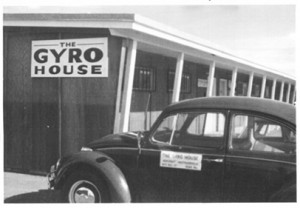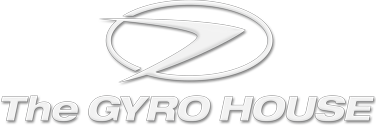History of the Company

The Gyro House was established by Emery “Claude” Oxley Senior in 1957. Claude originally began working out of his home in Riverside, California where he specialized in the repair of gyroscopes for General Aviation aircraft; hence the name “The Gyro House”. Early success allowed Claude to expand and he moved the company out of his home and into a facility at Flabob Airport, just west of Riverside. Claude’s’ reputation for quality work kept new clients coming in the door and not long after relocating to Flabob, he needed to expand once again. In 1960, Claude moved The Gyro House to the Riverside Municipal Airport.
“These early years were critical to the long term success of The Gyro House and Claude skillfully led the growing company.”
These early years were critical to the long term success of The Gyro House and Claude skillfully led the growing company. He built a foundation for the future by developing The Gyro House reputation as a top quality aircraft instrument repair facility with superior customer service. Throughout Claude’s tenure, The Gyro House specialized in general aviation gyroscopes, airspeed indicators and altimeters.
By 1963 Claude’s son, Emery Jr., was afforded the opportunity to learn instrument repair and overhaul from the bench up by working for his father. This experience and mentoring eventually provided Emery Jr. the confidence and skill to establish and manage his own company.
In 1973 Claude, who had been suffering from declining health, sold The Gyro House to Emery; who then moved the company to Auburn, California.
Nestled in the picturesque foothills of the Sierra Nevada mountain range and situated on the western edge of the Tahoe National Forest, Emery could hardly ask for a more soothing environment. The Gyro House was located at the Auburn Airport and was initially housed in a small wooden building with a simple office and attached hanger all situated just south of the runway centerline.
In 1973 a new steel building was constructed for The Gyro House. The new building was built adjacent to the existing wooden hangar occupied by The Gyro House and the company quickly expanded into the new space. The company offices and instrument shop were moved into the new facilities while still retaining use of the hangar in order to begin expansion into the area of autopilot sales and installation.
Emery shared his father’s natural skill as an entrepreneur and by 1975 the company sought and acquired dealerships for all of the major General Aviation avionics, instruments and autopilot manufacturers. This impressive list included but was not limited to:
- King Radio (Later to become Honeywell/Bendix/King)
- Narco Radio
- Edo-Aire (Later to be broken up and its various components to become Sigma-Tek and S-Tec)
- Cessna Radio

The various dealerships and the added customer base that came with them permitted the company to continually expand its repair and overhaul capabilities. Throughout the balance of the 1970’s and into the mid 1980’s, the company continually added repair capabilities and built up a substantial inventory of “ready to go” exchange instruments. The company continued to operate in this mode until 1990.
In the fall of 1988, Emery attended the annual meeting of the Aircraft Instrument Association in Wichita, Kansas. It was on this trip that he met with Richard T. Anderson. Both men knew of each other by reputation but it was their first face to face meeting and one which would lead to a long and mutually beneficial business relationship.
Rich had previously held engineering positions with Telephonics Corp of Huntington, New York and with Gull Airborne Electronics of Smithtown, New York and at the time of their meeting Rich was the General Manager of Tech-Aire Instruments in Wichita, KS.
In 1990 Emery offered Rich a position as Chief Engineer of The Gyro House. Rich accepted with the condition that he wanted freedom to expand the company. Emery agreed to provide the financial backing needed to expand the company’s capabilities into the commercial and military sectors of the industry.
By 1991 Rich had already designed and built the company’s first Fuel Flow Overhaul Laboratory. Emery provided funding and support for the project. At the same time Emery was busy expanding the company’s general aviation product line and inventory. Emery’s keen vision as an entrepreneur was demonstrated again when he entered into the Global Positioning System (GPS) market. Emery was one of the first aviation after market entrepreneurs to realize the potential of this new product line and The Gyro House began offering it for sale and installation as soon as they hit the market.
“‘The Gyro House’ name no longer defined the vastly expanded capabilities …the company now became TGH Aviation.”
In 1992 the McDonnell Douglas Company asked for Rich’s assistance to design a replacement power control switch for use in the cockpit of their aging DC8 fleet. As a result of that request and the subsequent successful design effort, The Gyro House received the company’s first FAA-PMA product approval. Also in 1992 the company was awarded their first contract with the United States Air Force for the overhaul of Fuel Flow Transmitters used on board the KC-135 refueling tanker. At this time the two men also decided to modernize the company name as “The Gyro House” name no longer defined the vastly expanded capabilities of the company and therefore was somewhat limiting in scope. The company now became TGH Aviation.
For the remainder of the 1990s the company continued to increase product lines, expand repair capabilities, design new products and add new facilities. In 1993 the original wooden hangar was refurbished changing it into a completely enclosed office building. This change allowed the instrument repair shop to expand so that it soon completely filled the areas of the existing steel building, which had housed offices earlier. Constant growth of TGH left no option but to build a new facility so in 1995 the company built an entirely new two story building, which is the current corporate facility.
By this time TGH was overhauling nearly 500 individual aircraft instruments per month. They also manufactured an original line of power switches, Flap Position Transmitters for DC10 and MD11 aircraft, Pitot/Static Test Systems, Low Voltage Warning Lights and Undersea Oxygen Controller Systems. TGH techs were also busy installing autopilots, avionics and GPS systems into General Aviation aircraft. TGH also built a third Fuel Flow Calibration Test Stand.
By 1995 the company had acquired a library of over 20,000 aircraft instrument maintenance manuals and had been approved by the Federal Aviation Administration to service all of the associated instrument types.
Also in 1995, The Gyro House was appointed by McDonnell Douglas as the sole authorized repair facility worldwide for the MD80, MD90 and MD11 aircraft Central Aural Warning Systems and Annunciator Control Units. This was a natural outcome as a result of Rich Anderson designing all of the test equipment for this equipment at Douglas’ request.
Upon entering into the new millennium the company had firmly established itself as a top quality aircraft instrument repair facility and had become known world-wide. Today TGH Aviation is a valued supplier to the United States Department of Defense, NATO and a world-wide network of aviation maintenance facilities and parts brokers while still maintaining its legacy customer base of General Aviation pilots.
Ownership
The Gyro House, d/b/a TGH Aviation is a privately held S corporation that is registered in the state of California. All shares in the corporation are held among the following individuals/entities:
- The Richard and Ann Anderson Family Trust


